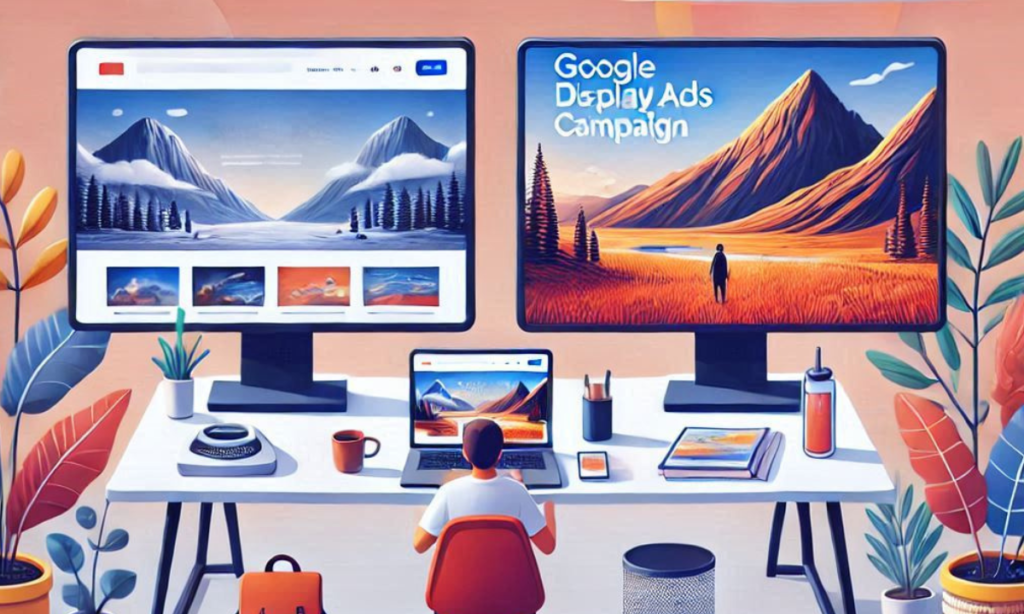Google Display Ads campaigns help businesses reach their audience and drive results. The Google Display Network covers over 90% of internet users worldwide. To make the most of your campaign, you can use Responsive Display Ads and Uploaded Image Ads.
In this article, we’ll explore these two ad formats. We’ll look at their features, benefits, and best practices. This will help you make smart choices for your campaigns. Let’s dive in!

1. Responsive Display Ads (RDA)
Responsive Display Ads are the go-to choice for Google Display Ads campaigns. They adjust their size and format to fit any ad space on the Google Display Network.
Features of Responsive Display Ads
- Dynamic Adaptability: RDAs adjust to fit different ad spaces. They look great on small mobile banners or large desktop ads.
- Automation: Google’s machine learning optimizes your ads. It tests different combinations to find the best ones.
- Customizable Assets: You can upload up to 15 images, 5 logos, 5 headlines, 5 descriptions, and 1 business name. Google creates multiple ad variations from these assets.
- Wide Reach: RDAs fit into various placements. This lets you reach a wider audience in the Display Network.
Benefits of Responsive Display Ads
- Ease of Creation: RDAs are easy to use. They’re perfect for beginners and experienced advertisers. You don’t need design skills or software to create great ads.
- Enhanced Performance: Google’s machine learning improves RDAs over time. It finds the best combinations for your audience.
- Cost-Effectiveness: RDAs automatically test different variations. This ensures your budget goes to high-performing ads.
- Improved Engagement: RDAs blend well with the content of the sites they appear on. They’re less intrusive and more engaging.
Best Practices for Responsive Display Ads
- High-Quality Assets: Use attractive images and logos that show your brand well. Make sure all visuals meet Google’s quality standards.
- Compelling Headlines and Descriptions: Write concise, engaging copy that highlights your unique selling points. Test different messages to find what works best.
- Diverse Assets: Provide a variety of images and text options. This gives Google more combinations to test and optimize.
- Regular Monitoring: Check performance reports to find top-performing assets. Use this to refine your strategy.

2. Uploaded Image Ads
Uploaded Image Ads, also known as Static Image Ads, are a traditional way to advertise. You create and upload ads in different sizes to the Google Display Network.
Features of Uploaded Image Ads
- Full Creative Control: You design the ads outside Google Ads. This gives you full control over the look and feel.
- Customizable Sizes: You can make ads in various sizes. This fits different places across the Display Network.
- Consistent Branding: These ads keep your brand’s look the same everywhere. You design every part of it.
- Rich Media Options: These ads support rich media formats. This includes animated GIFs and HTML5 for a more interactive experience.
Benefits of Uploaded Image Ads
- Precise Design: You can make ads that match your brand’s look and message perfectly.
- Flexibility in Creativity: Unlike RDAs, you control every part of the design. This includes colors and call-to-action placement.
- Brand Recognition: Static Image Ads help keep your brand’s look consistent. This reinforces your brand’s identity.
- Targeted Messaging: These ads are great for campaigns with a specific message. You can deliver a focused message.
Read More: What is A/B testing in Facebook ads? How does it work?
Best Practices for Uploaded Image Ads
- Design for Multiple Sizes: Make ads in all recommended sizes. This increases your reach across the Display Network.
- Mobile-Friendly Design: Make sure your ads work well on small screens. A lot of Display Network traffic comes from mobile devices.
- Call-to-Action (CTA): Use clear, action-oriented CTAs. This encourages users to take action, like “Shop Now” or “Sign Up.”
- File Size Optimization: Keep your file sizes small. This ensures fast loading times and better user experiences.

Comparing Responsive Display Ads and Uploaded Image Ads
| Feature/Aspect | Responsive Display Ads | Uploaded Image Ads |
|---|---|---|
| Creation | Created within Google Ads using assets | Designed externally and uploaded |
| Flexibility | Automatically adjusts to ad placements | Fixed sizes; no automatic adjustment |
| Optimization | Uses machine learning for performance | No automatic optimization |
| Ease of Use | Simple to create and manage | Requires design tools and expertise |
| Creative Control | Limited to provided assets | Full control over design |
| Ideal For | Broad reach, dynamic placements | Consistent branding, targeted ads |
Which Ad Format Should You Choose?
Responsive Display Ads and Uploaded Image Ads have their own strengths. The right choice depends on your goals, resources, and audience.
- Choose Responsive Display Ads if:
- You want a quick and easy way to create ads.
- You lack advanced design skills or resources.
- Your goal is to reach a wide audience with adaptable ads.
- You prefer automation and performance optimization.
- Choose Uploaded Image Ads if:
- You have a strong in-house or outsourced design team.
- You need complete control over your ad’s appearance.
- Your campaign requires specific branding and messaging.
- You’re running a focused promotion with fixed creatives.
Tips for a Successful Google Display Ads Campaign
Here are some tips to boost your campaign’s success, no matter the ad format:
- Audience Targeting: Use advanced targeting options, such as demographic targeting, interest targeting, and remarketing, to reach the right users.
- Compelling Visuals: Invest in high-quality images and designs that grab attention and communicate your message effectively.
- Consistent Testing: Regularly A/B test different ad creatives, headlines, and descriptions to identify what resonates with your audience.
- Landing Page Optimization: Ensure your landing pages align with your ad’s messaging and provide a seamless user experience.
- Monitor and Adjust: Continuously analyze your campaign’s performance and make data-driven adjustments to improve results.
Conclusion
Knowing the two main ad formats in Google Display Ads is key to success. Responsive Display Ads are great for adaptability and automation. Uploaded Image Ads offer precise control and branding consistency. By using these formats wisely, you can make campaigns that engage, convert, and grow your business.
Whether you’re experienced or new to Google Display Ads, trying both formats is a good idea. It helps you find the best strategy for your goals. Start optimizing your campaigns today and unlock the full potential of the Google Display Network!
Frequently Asked Questions
1. What are the two main ad formats used in Google Display Ads campaigns?
The two primary ad formats are:
- Responsive Display Ads: Automatically adapt to different sizes, formats, and placements using assets provided by the advertiser.
- Uploaded Image Ads: Custom-designed ads that give advertisers full creative control over the design and messaging.
2. Which ad format is better for a business with limited design resources?
Responsive Display Ads are ideal for businesses with limited design resources. These ads automatically combine provided assets, such as headlines, images, and descriptions, into optimized ads for various placements.
3. Can I use both Responsive Display Ads and Uploaded Image Ads in the same campaign?
Yes, combining both formats in a campaign is a common strategy. It allows advertisers to leverage the broad reach and adaptability of Responsive Display Ads while maintaining the brand consistency and customization offered by Uploaded Image Ads.
4. How does Google optimize Responsive Display Ads?
Google uses machine learning to test different combinations of the provided assets (headlines, images, descriptions, etc.). It identifies and prioritizes the best-performing combinations to maximize engagement and results.
5. What are the specifications for Uploaded Image Ads?
Uploaded Image Ads must meet Google’s technical requirements, which include:
- Accepted formats: JPG, PNG, GIF
- Maximum file size: 150 KB
- Dimensions: Must match the specified sizes for display ads (e.g., 300×250, 728×90, 160×600, etc.)
6. What kind of assets do I need for Responsive Display Ads?
For Responsive Display Ads, you’ll need:
- Headlines (short and long versions)
- Descriptions
- Images (landscape and square)
- Logos
- A call-to-action
Google combines these assets to create visually appealing and effective ads.
7. Are there any costs associated with using one format over the other?
The cost of using either format depends on your campaign strategy, targeting, and bidding, rather than the format itself. However, Responsive Display Ads might save time and reduce costs associated with designing custom creatives.
8. How do I measure the performance of my ads?
Use the following metrics in Google Ads to evaluate performance:
- Impressions: Total number of times your ads were shown.
- Clicks: Number of clicks your ads received.
- Conversions: Actions taken by users after clicking on your ads.
- CTR (Click-Through Rate): Percentage of impressions that resulted in clicks.
- CPA (Cost Per Acquisition): Average cost to acquire a customer.
9. Can I edit Responsive Display Ads after publishing them?
Yes, you can edit your Responsive Display Ads at any time. Google will automatically update the ads across all placements, ensuring continued optimization.
10. What are the best practices for improving ad performance?
- Use high-quality assets that reflect your brand.
- Ensure your headlines and descriptions are clear and compelling.
- Include a strong call-to-action (CTA) to guide users.
- Test both ad formats to determine what works best for your target audience.
- Continuously monitor and optimize your campaigns based on performance data.
𝐒𝐰𝐚𝐠𝐚𝐭 𝐆𝐚𝐰𝐚𝐝𝐞
Digital Marketer | Content Creator | Growth Strategist
With 2 years of hands-on experience in the dynamic world of digital marketing, Swagat Gawade specializes in crafting compelling strategies that drive growth and engagement. From managing ad campaigns to optimizing SEO, Swagat has a proven track record of boosting brand visibility and achieving measurable results.
Key skills:
𝐒𝐨𝐜𝐢𝐚𝐥 𝐌𝐞𝐝𝐢𝐚 𝐌𝐚𝐫𝐤𝐞𝐭𝐢𝐧𝐠: Building impactful campaigns that resonate with audiences.
𝐂𝐨𝐧𝐭𝐞𝐧𝐭 𝐌𝐚𝐫𝐤𝐞𝐭𝐢𝐧𝐠: Creating engaging, high-quality content tailored to target markets.
𝐒𝐄𝐎 & 𝐒𝐄𝐌 𝐄𝐱𝐩𝐞𝐫𝐭𝐢𝐬𝐞: Ensuring brands rank high and stay competitive in search results.
𝐀𝐧𝐚𝐥𝐲𝐭𝐢𝐜𝐬 𝐏𝐫𝐨𝐟𝐢𝐜𝐢𝐞𝐧𝐜𝐲: Leveraging data to refine strategies and enhance ROI.
Swagat’s passion for learning fuels a constant pursuit of innovative marketing solutions, making him a valuable asset in today’s fast-evolving digital landscape.


